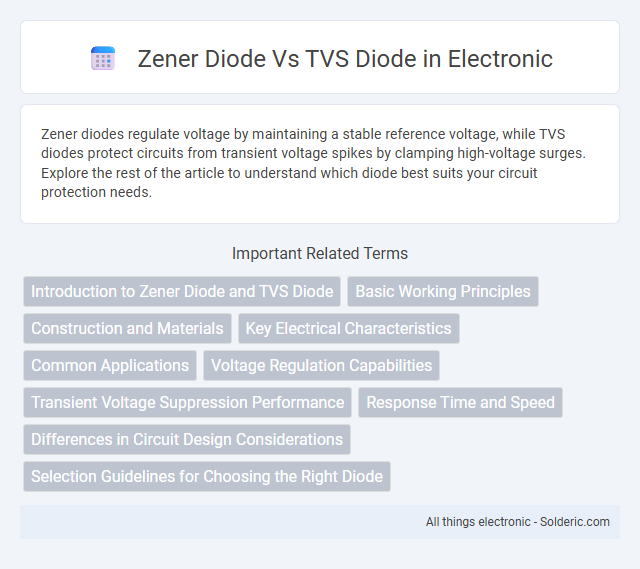Zener diodes regulate voltage by maintaining a stable reference voltage, while TVS diodes protect circuits from transient voltage spikes by clamping high-voltage surges. Explore the rest of the article to understand which diode best suits your circuit protection needs.
Comparison Table
| Feature | Zener Diode | TVS Diode (Transient Voltage Suppressor) |
|---|---|---|
| Primary Function | Voltage regulation and reference | Transient voltage spike protection |
| Operating Voltage | Typically low to moderate (e.g., 2.4V to 200V) | Wide range for transient suppression (up to kV levels) |
| Response Time | Moderate | Nanoseconds (very fast) |
| Surge Current Capability | Low to moderate | High (designed for high energy absorption) |
| Typical Applications | Voltage reference, voltage clamping, voltage regulation | Protecting sensitive electronics from ESD, lightning, and switching transients |
| Construction | Standard PN junction diode designed for Zener breakdown | Robust diode optimized for avalanche breakdown during transient events |
| Cost | Lower cost | Relatively higher cost due to protective function |
Introduction to Zener Diode and TVS Diode
Zener diodes are semiconductor devices designed to allow current to flow in the reverse direction when a specific breakdown voltage is reached, providing voltage regulation and protection in electronic circuits. TVS (Transient Voltage Suppression) diodes are specialized components engineered to protect sensitive electronics from voltage spikes by clamping transient overvoltages quickly and safely. Understanding the differences in their voltage clamping characteristics and response times can help you choose the appropriate diode for surge protection or voltage regulation applications.
Basic Working Principles
Zener diodes regulate voltage by operating in the breakdown region, maintaining a constant voltage across sensitive electronic circuits during overvoltage conditions. TVS (Transient Voltage Suppression) diodes rapidly clamp voltage spikes and transient surges, protecting circuits from sudden high-energy events such as electrostatic discharge or lightning strikes. While Zener diodes provide stable reference voltage for voltage regulation, TVS diodes serve as fast-acting protective devices designed to absorb transient energy and prevent damage.
Construction and Materials
Zener diodes are constructed with a heavily doped p-n junction, designed to operate in the breakdown region at precise voltage levels using silicon semiconductor materials. TVS (Transient Voltage Suppression) diodes consist of multiple p-n junctions in a robust silicon-based structure optimized for fast response and high surge current capability. The doping concentration and structural design differences enable Zener diodes to provide voltage regulation, while TVS diodes offer transient voltage protection.
Key Electrical Characteristics
Zener diodes exhibit a precise breakdown voltage typically ranging from a few volts up to several hundred volts, enabling voltage regulation by maintaining a constant voltage across circuits. TVS (Transient Voltage Suppressor) diodes feature ultra-fast response times in the nanosecond range and can handle high peak pulse currents from tens to thousands of amperes, providing robust protection against transient voltage spikes. Both devices differ mainly in their power dissipation ratings, breakdown voltage tolerances, and intended applications, with Zener diodes optimized for voltage reference and TVS diodes specialized for transient overvoltage protection.
Common Applications
Zener diodes are primarily used for voltage regulation and voltage reference in low-power electronic circuits, ensuring stable voltage levels in power supplies and signal conditioning. TVS diodes serve as essential components in protecting sensitive electronics from transient voltage spikes caused by electrostatic discharge, lightning, and switching surges in power lines and communication systems. You can choose a Zener diode for precise voltage regulation, while TVS diodes are ideal for robust surge protection in automotive, industrial, and consumer electronics applications.
Voltage Regulation Capabilities
Zener diodes provide precise voltage regulation by maintaining a constant output voltage within their breakdown voltage range, making them ideal for low-voltage reference and stabilization applications. TVS (Transient Voltage Suppressor) diodes offer rapid response to voltage spikes, protecting circuits by clamping high transient voltages without continuous regulation. While Zener diodes excel in steady-state voltage regulation, TVS diodes specialize in transient voltage suppression to safeguard sensitive electronic components.
Transient Voltage Suppression Performance
Zener diodes offer precise voltage regulation by maintaining a stable reference voltage during transient events, making them suitable for low-energy transient suppression. TVS diodes are specifically designed to handle high-energy transient voltage spikes instantly, clamping voltage surges with fast response times and high peak pulse power ratings. Their superior transient voltage suppression performance ensures effective protection for sensitive electronic circuits against electrostatic discharges and lightning-induced surges.
Response Time and Speed
Zener diodes typically have a slower response time compared to TVS diodes, making TVS diodes ideal for rapid transient voltage suppression in sensitive electronic circuits. TVS diodes are designed to respond within picoseconds to nanoseconds, effectively clamping voltage spikes before they can damage components. Understanding the speed difference between your Zener and TVS diodes ensures optimal protection tailored to your circuit's transient response requirements.
Differences in Circuit Design Considerations
Zener diodes are primarily used for voltage regulation by maintaining a stable reference voltage in low-current circuits, while TVS diodes are designed for transient voltage suppression to protect sensitive components from high-energy spikes and surges. Circuit design considerations for Zener diodes involve selecting an appropriate breakdown voltage and power rating to ensure consistent voltage regulation without excessive heat dissipation. Your choice between the two depends on whether you need steady voltage stabilization (Zener) or robust transient protection (TVS), influencing component placement, current limiting, and thermal management in the circuit layout.
Selection Guidelines for Choosing the Right Diode
Selecting the right diode between a Zener diode and a TVS diode depends on your application's voltage regulation or transient voltage suppression needs. Zener diodes are ideal for precise voltage regulation in low-power circuits, offering stable reference voltages and maintaining a constant voltage across components. For protecting sensitive electronics from voltage spikes and transient surges, TVS diodes provide fast response and high peak pulse power handling, ensuring reliable suppression of transient overvoltages to safeguard your devices.
Zener Diode vs TVS Diode Infographic

 solderic.com
solderic.com